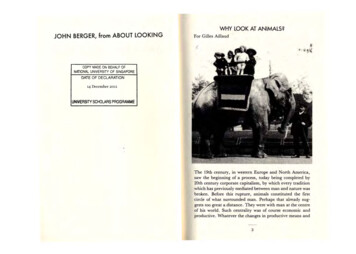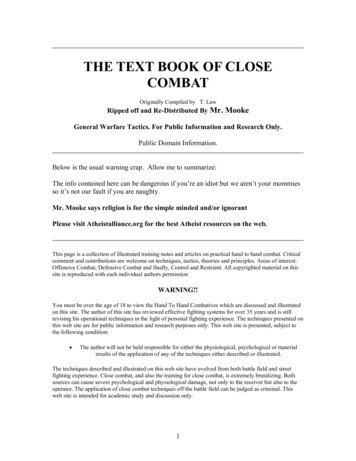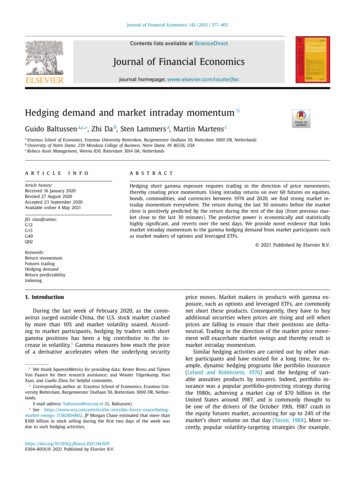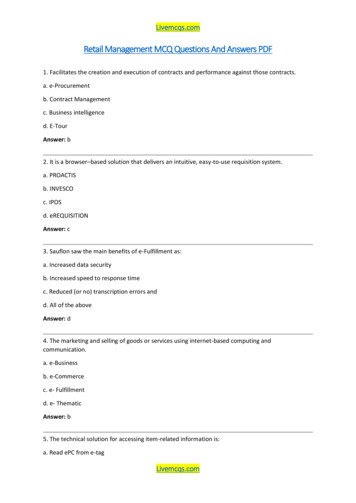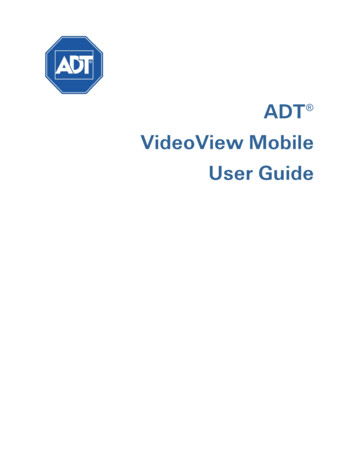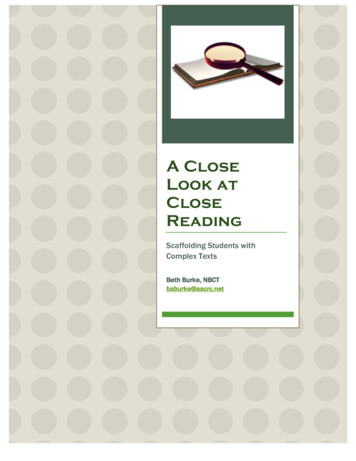
Transcription
A CloseLook atCloseReadingScaffolding Students withComplex TextsBeth Burke, NBCTbaburke@aacrc.net
Table of ContentsWhat Is Close Reading? . 2Selecting a Text . 3What Makes Text Complex? . 4Steps in Close Reading . 5Scaffolding Students in Close Reading . 6Close Reading Template . 7Close Reading Sample Lesson . 8Spelunking (article) . 9Text Dependent Questions . 10baburke@aacrc.net1
What Is Close Reading?Close reading is thoughtful, critical analysis of a text that focuses on significant details orpatterns in order to develop a deep, precise understanding of the text’s form, craft, meanings,etc. It is a key requirement of the Common Core State Standards and directs the reader’sattention to the text itself.Close reading includes: Using short passages and excerptsDiving right into the text with limited pre-reading activitiesFocusing on the text itselfRereading deliberatelyReading with a pencilNoticing things that are confusingDiscussing the text with otherso Think-Pair Share or Turn and Talk frequentlyo Small groups and whole classResponding to text-dependent questionsbaburke@aacrc.net2
Selecting a TextNot every text is appropriate for students to read closely. For example, while students enjoyreading Diary of a Wimpy Kid books, these novels offer simple story lines and vocabulary thatare easily understandable. When you are done reading them, they don’t leave you ponderingdeep ideas. Close reading should leave you considering thought-provoking messages that gobeyond the text.Close read-worthy texts include enough complex ideas worthy of exploring and discussing tosustain one or more days of instruction. According to Tim Shanahan, close reading is a multiday commitment to a text; you want students to read a text that offers rich enough vocabulary,ideas, and information to read, examine, and discuss over those days without feeling like you’rebeating a dead horse.When selecting a text, you need to considerthe three components of text complexity:Qualitative measures, Quantitativemeasures, and the Reader and the Task.Each of these is equally important whenconsidering the complexity of a text.Questions to consider:Qualitative motivation, prior knowledge,Does this text offer ideas or informationexperiences, etc.that further students understanding ofthe topic?Does the text include a text structure that Does the text follow familiar language conventions—sentence structures, word choices, etc.?What background knowledge do my students need to have to be successful with this text?Quantitative Is this text on an appropriate readability level for the students in my group? How can I scaffoldmy students to ensure their success with this text?*The primary leveling tool used by the Common Core is Lexile. For more information orto find the lexile of a text, visit Lexile.com.Reader and Task Considerations How much prior knowledge do my students have about this topic?How interested are they?What will be difficult for my students in reading this passage?Appendix B of the Common Core State Standards includes sample lists of exemplar texts thatgive you an idea of what complex texts look like in each of the grade level bands.baburke@aacrc.net3
What Makes Text Complex?Close reading should occur with appropriately complex text. There are a number of factors thatcontribute to text complexity. Teachers should differentiate, or vary, how they approach a textwith students depending on the text complexity and students’ needs. Vocabularyo Academic and domain-specific termso Tier 2 vocabulary: high utility complex words that can be used in multiplecontextsSyntax Coherence—Are the events and concepts logically connected and clearlyexplained? Unity—Do the ideas focus on the topic and not include irrelevant or distractinginformation? Audience appropriateness—Does the text match the background knowledge ofthe target reader?Text structures Description Compare and Contrast Temporal Sequence Cause and Effect Problem and SolutionText features Headings/subheadings Signal wordsbaburke@aacrc.net4
Steps in Close ReadingThere is no specific sequence in a close read; these steps are meant to generally guide you incrafting a lesson that scaffolds students and focuses on increasingly complex text dependentquestions. Begin with questions about the big ideas in the text and gradually ask higher levelquestions.1. FIRST READ: KEY IDEAS AND DETAILSSet the purpose for reading and have students read text as independently as possible.Depending on the text complexity and the readers, the first read may be doneindependently, as a read aloud/think aloud, or paired or shared reading. The first readshould be without building background; students should be integrating their backgroundknowledge with the text as they read. Focus on the key ideas and details in the text, makingsure that readers know the main idea, story elements, or key details that the authorincludes.Following the first read, have students Think-Pair-Share to assess what they havegleaned from the text. By listening to students as they share, you can determine thefocus of the first read, etc.2. SECOND READ: CRAFT AND STRUCTUREFor a second, close read, select a portion or chunk of the text that is “close read worthy.”That is, have students reread a section that includes complex elements or ideas that theyshould explore to arrive at a deep understanding of the text. After rereading, studentsdiscuss the text with partners or in small groups, focusing on the author’s craft andorganizational patterns. This may include vocabulary choices, text structure or text featuresthat they author included.Use a Text Dependent Question to focus or set a purpose for a close rereading. Afterstudents share with partners or in small groups, have groups share out with entire classto assess understanding.3. THIRD READ: INTEGRATION OF KNOWLEDGE AND IDEASThe third close reading of a text should go even deeper, requiring students to synthesize andanalyze information from several texts or media. They may record their ideas on stickynotes, graphic organizer, or a thinking sheet.Have students journal a response to a Text Dependent Question. Focus the discussionon text evidence.baburke@aacrc.net5
Scaffolding Students in Close ReadingWhile the goal for students is to read complex texts independently, not all students will be ableto achieve that immediately. Scaffolding instruction is a model in which the teacher supportsstudents and gradually releases responsibility to the student. Pearson and Gallagher (1983)coined this term based on the 1970’s work of Vygotsky. A key model in scaffolding instruction isthe Gradual Release of Responsibility. In this model, the teacher begins by modeling, offeringstudents the highest level of support. As instruction continues and the teacher monitorsstudents’ learning progress, he/she gradually releases responsibility to the students, guidingstudents’ progress and eventually observing as they practice the skill independently (Pearsonand Gallagher, 1983).Close reading may be scaffolded throughthese teaching methods: Shared readingInteractive read aloudComprehension Toolkit lessonsQARLiterature circlesQuestioning the authorReciprocal teachingConnecting to themes/essentialquestionsPost-itsThink sheetsJigsawsFor students who are struggling, you may support them though a Think-Aloud, reading the text tothe students and modeling your thinking as you answer a Text Dependent Question. Asstudents become more proficient in reading, discussing, and analyzing text, you may graduallyrelease the responsibility for reading & thinking to them. The idea is to offer just the rightamount of support so that students can be successful.baburke@aacrc.net6
TextStructure TextFeatures Audience Appropriateness Coherence3.baburke@aacrc.netCCSS2. CCSS1. CCSSSelect 2-3 high cognitive level questions that will require students touse the author’s words. Prompt to use text evidence. (These cancorrespond to the three steps in the lesson.)Text-Dependent Question(s) Syntax VocabularyComplex ideas that require close reading(photocopy or mark section)Focus chunk/portion for close readTeacher:Text (worthy of a close read):Close Reading TemplateDate:Discuss in small and whole groupJournaling with text dependent questionportions of text that will aid in citing text based evidenceStudents use pencils, post-it or highlighters to mark textModes: independent, shared, paired reading; read aloud/ think aloud3. THIRD READ (Integration of Knowledge and Ideas)Reread selected chunk focusing on text dependent questionDiscuss in small and whole groupportions of text that will aid in citing text based evidenceStudents use pencils, post-it or highlighters to mark textIndependent Reading Read Aloud, Think Aloud, Shared, Paired,2. SECOND READ (Craft & Structure)Reread selected chunk focusing on text dependent question7Think-Pair-Share to check understanding (Use to focus close reading.)1. FIRST READ (Key Ideas & Details)Students read text (*Do not activate prior knowledge or use pre-readingactivities)StepsGrade:
Audience Appropriateness CoherenceCCSS RI.1baburke@aacrc.netFind evidence in the text that the author thinks spelunking isexciting.3.How did the author organize this text? How do you know?2. CCSS RI.1Tell what people do and see when they go spelunking.1. CCSS RI.1Select 2-3 high cognitive level questions that will require students touse the author’s words. Prompt to use text evidence. (These cancorrespond to the three steps in the lesson.)Text-Dependent Question(s) Syntax Vocabulary TextStructure TextFeaturesComplex ideas that require close reading(photocopy or mark section)Focus chunk/portion for close readSpelunkingTeacher: BBText (worthy of a close read):Close Reading Sample LessonDate:Model crafting a journal entry citing text evidence to answer question # 2.Discuss in small and whole groupJournaling with text dependent questionportions of text that will aid in citing text based evidenceStudents use pencils, post-it or highlighters to mark textModes: independent, shared, paired reading; read aloud/ think aloudDiscuss, model and guide students to answer question # 3.3. THIRD READ (Integration of Knowledge and Ideas)Reread selected chunk focusing on text dependent question8Students work with partners to find text evidence to answer question # 2; shareresponses and discuss.Discuss in small and whole groupportions of text that will aid in citing text based evidenceStudents use pencils, post-it or highlighters to mark textIndependent Reading Read Aloud, Think Aloud, Shared, Paired,Model finding text evidence to answer question # 2.2. SECOND READ (Craft & Structure)Reread selected chunk focusing on text dependent questionTell your partner what someone does when they spelunk.Think-Pair-Share to check understanding (Use to focus close reading.)Set purpose: Read to find out what spelunking is.1. FIRST READ (Key Ideas & Details)Students read text (*Do not activate prior knowledge or use pre-readingactivities)StepsGrade: 3
Spelunkingby B. WilkinsSpelunking is the exciting sport of cave exploration thatcan be enjoyed by all ages. When you explore caves, youcan appreciate the wonders of our world beneath theearth.Many caves can maintain a steady non-fluctuatingtemperature that is comfortable year-round becausecaves are underground and not subject to airtemperatures and the sun. So, spelunkers can experienceadventures at any time of the year.from a dripstone deposit in the cavern are said to growone inch every 100 years. You can also find calcite crystalsin caves.The Cave HabitatIf you like creepy crawlies, you will love exploring in caves.You can expect to see bats as well as cave crickets,spiders, and algae. Most bats are only about four inchesor smaller from head to tail. Bats can sleep for five daysand leave the cave for one day to find food. The bats areharmless and will not attack people as the moviessuggest.Cave FormationCaves are formed over thousands of years through a veryslow process. As it rains, rain droplets absorb smallamounts of carbon dioxide. The droplets gather morecarbon dioxide as they move through soil. Water mixedwith carbon dioxide becomes an acid solution, whichmakes holes and channels in rocks. Over thousands ofyears, caves are formed.Natural BeautyAs caves are formed, they develop breathtaking columnswhich reach from the ceiling to the floor or from the floorto the ceiling. The icicle-shaped rocks that hang downfrom the ceiling are called stalactites (stal ACK tites). Theicicle-shaped rocks that push up from the café floor arecalled stalagmites (stal AG mites).Generally, thedark coloredstalactites andstalagmites areconsidered to bedead and the lightcolored ones areREMEMBERliving. “Dead”Stalagmites push up with all their“mite” from the floor, while stalactitessimply means thathold onto the ceiling really “tite.”they are no longerreceiving agrowth source. Scientists believe that it takes nearly athousand years for a stalactite to grow. Formations madebaburke@aacrc.netSpelunking DangersSpelunkers should always travel with someone who isfamiliar with the cave in which they are traveling. In thewinding maze of cave tunnels, it is easy to lose the way.Also, deadly gases which are colorless and odorless maybe present and are undetectable to spelunkers. Specialequipment can be purchased that will detect harmfulgases.If you are a risk-taker who craves adventure, spelunking isfor you!Spelunking Rules Never go alone. Go with someone who is familiar with the cave. Tell someone where you are going, and whenyou expect to return. Take at least 3 sources of light per person(flashlights, carbide lamps, candles, etc.). Wear proper hiking shoes. Dress in clothing that can protect the skin fromcuts, bites, and scrapes. Do not go into caves when it is raining, or whenit might rain. Caves can flood in a short time. Carry plenty of water and snacks. Bring something to mark your path, such asrope, chalk, or string. Mark your path clearly and frequently.9
First Read—focus on most importantelements of a text (Key Ideas and Details)Second Read—focus on how the textworks (Craft and Structure)Third Read—focus on what the textmeans to the reader and how it connectsto other experiences (Integration ofKnowledge and Ideas)baburke@aacrc.netThe question stems on the following pages are samples of the types ofquestions that require students to revisit and use information in a text. ThereQuestion StemsStandard 1 requires students to be able quote accurately and appropriately.That is, they have to select the right information to support their answer. Inaddition, students should be able to use proper punctuation to quote anoriginal text.Quote Accurately Ask text dependent questions as part of a close reading routine. After aninitial reading, encourage students to go back to the text to find details in thetext to support their answers. Reread the text several times over severaldays:Close Reading RoutineTo craft effective text dependent questions, you mustread and understand the text thoroughly. As you plan alesson, begin with the end in mind: what do you want students to be able toknow and do as a result of the lesson? This may be a written or oral response.Text Dependent Questions are a critical element inthe Common Core State Standards. They requirestudents to dig deeply into the text to answer them. Infact, a text dependent question cannot be answeredwithout using the text; background knowledge and priorexperiences should not be included or considered.Text Dependent Questions10 Remember to use textual evidence to support your ideas. Remember to use words and phrases from the text toprove your answer. Be sure to include specific evidence from the text tosupport your ideas. Be sure to include specific words and phrases from the textto support your opinion. Use specific words or details from the text or illustrations tosupport your ideas. Inferences should be supported by text. What in the text helped you to know? What words and phrases did the author use that led you toyour answer?Try one of these cues after a Text DependentQuestion:Effective Text Dependent Questions require students to go back to the textin order to answer them. Add a cue to direct students back to the text tothe end of your Text Dependent Question. Questions like “You just readabout dog. Tell about a time you played with a dog.”Revisiting the Textare sample questions for each CCSS Standard, sorted by category (Key Ideasand Details, Craft and Structure, Integration of Knowledge and Ideas).Standard 10 focuses on the depth and breadth of the texts that students readand is addressed continuously in reading instruction.
baburke@aacrc.net1. Read closely to determine what the textsays explicitly and to make logicalinferences from it; cite specific textualevidence when writing or speaking tosupport conclusions drawn from the text. What are the key ideas in this text/story? What can you infer from the title, headings,and anecdotes in this book? Who was the most important character in thestory? What makes Who, what, where, when, how questions What key details help support the main idea of? What key details and/or examples support themain idea of ? What have you learned from this [text]? Identify characters, setting, major events, Explain key details that support the author’smessage. Compare and contrast (characters, setting,events, etc.). Explain how and interact in thisstory. Describe how (name of character) respond to(major event and/or challenge). Explain how (name of character) changed inthe story. Why does think about ? How does feel about ? How does show persistence (orother character trait) in ? How does this help the reader learn moreabout ’s character? What can we infer about the charactersand ? What do readers learn about the family’srelationship from this section? What does ’s conversation withreveal? What event did the author include to showthe reader ? Describe connections between . Explain relationships or interactions between 2or more (individuals, events, ideas, concepts)in this text based on specific information in it. Explain the procedures described in thisarticle. Retell the story. What is the story or article beginning to beabout? What is the theme of the story? What message was the author trying to share? What could the main character have learnedthat I could also learn? What was a moral or lesson in the story? Summarize the text. Retell the (fables, folk tales from diversecultures). What is the main idea of this text? What are the 2 or more main ideas in thistext? What key supporting details did the authorcite?113. Analyze how and why individuals,events, and ideas develop and interactover the course of a text.2. Determine central ideas or themes of atext and analyze their development;summarize the key supporting details andideas.Key Ideas and DetailsText Dependent Questions
baburke@aacrc.net4. Interpret words and phrases as they areused in a text, including determiningtechnical, connotative, and figurativemeanings, and analyze how specific wordchoices shape meaning or tone. What does (word or phrase from the story,figurative language, sensory word,) mean? What does Herculean (or other Mythologyvocabulary) mean in this story? Describe how words and phrases (regularbeats, alliteration, rhymes, repeated lines)supply rhythm and meaning in a story, poemor song What kind of text is this? (poem, drama, prose,etc.) How do you know? Explain the meaning of (general academicvocabulary word). Explain what (domain/content specific word)means. Which words really call our attention here?What do we notice as we reread them? How does the author’s choice of words, thetone of the language, illuminate the author’spoint of view on the topic?5. Analyze the structure of texts, includinghow specific sentences, paragraphs, andlarger portions of the text (e.g., a section,chapter, scene, or stanza) relate to eachother and the whole. What was the (problem, solution)? How do (series of chapters, scenes, stanzas) fittogether to provide overall structure in thistext? What text structure did the author use in thistext? What kind of text is this? (story, article, etc.) Look back at the text and see if you can divideit into parts. What parts does the authorinclude? Describe the story structure, includingbeginning, middle, and ending Describe the (action, setting) in the story. Explain the (structure elements: verse, rhythm,meter of this poem). Explain the (structure elements: cast ofcharacters, settings, descriptions, dialogue,stage directions) of this drama/play. What might have happened if hadn’thappened first? How did the author organize the ideas in the(article, book, etc.)? Explain how you know that the author used atext structure. What text structure did the author use?Craft and StructureText Dependent Questions 12From what point of view is this story told?Who is narrating the story? How do we know?Through whose eyes did you see this story?Read (two or more accounts of the sameevent/topic). Analyze the information theauthors present.What similarities and/or differences are therein (titles of two texts on similar topics)?How does the author feel about (topic)?How did the graphics help you understand thesection about ?Distinguish between information provided bypictures and words in the text.How does your own point of view compare tothe author of ?6. Assess how point of view or purposeshapes the content and style of a text.
baburke@aacrc.net Not applicable in Literature—InformationTexts only Describe (character, setting, event). Usespecific examples from the illustrationsand/or words. Use illustrations and words in print or digitaltext to demonstrate understanding ofcharacters/setting/ plot. How did the author use illustrations toengage the reader in the events of the story? How do the (visual/multimedia elements)help the reader understand the author’smessage? Use illustrations and details in a text todescribe key ideas. What text features (headings, table ofcontents, glossaries, electronic menus, icons)did the author include to help the reader? How did search tools (key words, side bars,hyperlinks) help the reader? How do the [pictures, etc.] help convey themood of the story? Identify the reasons an author gives to supporthis key point(s). Explain how author uses reasons and evidenceto support the main idea of . Identify which reasons/evidence support whichpoint(s). What is the author’s point of view on thetopic? What in the text makes you say that? Describe logical connections between specificsentences and paragraphs. Explain cause and effect relationships in thestory/text. What was the tone of the story/text?8. Delineate and evaluate theargument and specific claims in a text,including the validity of the reasoningas well as the relevance and sufficiencyof the evidence.7. Integrate and evaluate contentpresented in diverse formats andmedia, including visually andquantitatively, as well as in words.*13 Compare (characters, titles from the samegenre, theme, topic, versions of the samestory, etc.). Identify similarities and differences betweentwo texts on the same topic. Read several texts on the same topic. Writea speech using information from each ofsource. Compare the text to: a movie, webpage,video game, piece of art or music, or othermedia. How does this selection connect to thetheme of ? How does this selection connect to (othertext we have read, content area, etc.) How is in paragraphs 1 and 2 likethat same idea in paragraphs 3 through 6? How is shown in paragraphs 7-11? What mood does the author create?9. Analyze how two or more textsaddress similar themes or topics inorder to build knowledge or tocompare the approaches the authorstake.Integration of Knowledge and IdeasText Dependent Questions
deep ideas. Close reading should leave you considering thought-provoking messages that go beyond the text. Close read-worthy texts include enough complex ideas worthy of exploring and discussing to sustain one or more days of instruction. According to Tim Shanahan, close reading is a multi-
